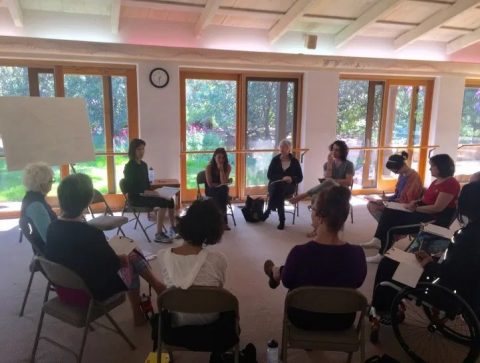A story always needs a setting, no matter what it’s about. Because “Nothing happens nowhere,” as the saying goes. Setting is about so much more than place though. It can be used to reveal character and mood, foreshadow what’s to come, or show not tell. How? By using one of my favorite literary devices: the objective correlative.
I’m not a particularly observant person, especially when it comes to visual cues. My kids make fun of me, because I don’t notice what people are wearing, what kind of cars they drive, or even the color of their hair. My default mode has always been to live in my head. That’s where I make up stories, create character conversations, write to do lists, and wonder things like how many people are actually going to read this blog.

As a writer, it’s good to have an active inner life, but you need to notice what’s going on outside of you too. But even when I remember to be consciously aware of my surroundings, I still agonize over which setting details to describe. Thanks to our brain’s “sensual selectivity,” only a small number of the sensory impressions that inundate us will register in our consciousness at any given moment. What makes that selection for us? The answer is, our emotions do.
 The act of linking setting description to character emotion is one way to use the objective correlative, also known as telling it slant. Tell it/slant is all about focusing on details that help the reader understand what you’re trying to convey—like insight into the narrator’s emotional state or a foreshadowing of what’s to come. “The trick is not to find a fresh setting or a unique way to portray a familiar place,” explains writer Donald Maass, “rather, it is to discover in your setting what is unique for your characters, if not for you.” Thus, a fictional environment comes alive partly in its details and partly in the way that characters experience those details.
The act of linking setting description to character emotion is one way to use the objective correlative, also known as telling it slant. Tell it/slant is all about focusing on details that help the reader understand what you’re trying to convey—like insight into the narrator’s emotional state or a foreshadowing of what’s to come. “The trick is not to find a fresh setting or a unique way to portray a familiar place,” explains writer Donald Maass, “rather, it is to discover in your setting what is unique for your characters, if not for you.” Thus, a fictional environment comes alive partly in its details and partly in the way that characters experience those details.
In order to tell it/slant, you’ll need to identify your scene objective. If your goal is to shed light on a teenage girl, you might choose to describe her room. The objects we surround ourselves with reveal much about our personalities. Is she into books or computer games? Do we see volleyball posters and muddy cleats or a shelf filled with art supplies? Stuffed animals or a bathroom counter filled with makeup and six different kinds of lip-gloss? Every object in the room should tell a story.
Next, how does your character react to the setting? In Writing Irresistible Kidlit, author Mary Kole cites New York City, for instance, as a place that stirs strong, often contrasting emotions in people.

 “I love New York City,” she admits. “I love the burning grease smell from the halal carts and the sticky sweet aroma of roasting peanuts that seems to hit me on every corner. My heart swells at the dank wind that a speeding subway train churns up as it pulls out of a station.”
“I love New York City,” she admits. “I love the burning grease smell from the halal carts and the sticky sweet aroma of roasting peanuts that seems to hit me on every corner. My heart swells at the dank wind that a speeding subway train churns up as it pulls out of a station.”
But for the folks who hate New York, Kole says, “All the people on the sidewalks might have shifty eyes, rats might lurk in every sewer grate and everything would seem astronomically expensive, especially the closet-sized hotel rooms.”
Same city, different perspective.
A character’s mood determines how she’ll react to and interact with her surroundings as well. A bedroom can be a safe haven, or it can feel like a prison if a teenager’s been banished there after being grounded by angry parents. Our state of mind colors how we perceive our surroundings. In this way, our settings can multitask.

Try the following exercise. Pick a place like a kitchen. Write a paragraph describing that kitchen from the point of view of a character who’s in a happy, relaxed, and positive mood–but don’t mention how the character is feeling. Then flip it and describe the same kitchen, but this time, put your character in an angry, fearful or negative frame of mind. Then compare the passages. Details like chicken noodle soup simmering on the stovetop and a cat purring on your lap vs. a sticky floor littered with dog hair, a sink filled with dirty dishes, and a spider crawling up a cracked window beautifully illustrate how different states of mind can impact what we notice. It’s all about showing, not telling.
A student of mine, 14-year-old Luna Patience, did a great job with this exercise in a workshop I taught last fall at the TeenSpeak Novel Workshop and Retreat. With her permission, I’m quoting from two passages she wrote using a graveyard setting. Note her use of imagery and strong verbs:
(Negative mood) “The sky overhead grumbles with oncoming clouds, and the freshly turned earth smells of mold and petrichor. As rain begins to spit from the sky, the thin coat that Leonard loaned me… is immediately soaked. Rainwater streams into my boots…pooling around my toes; filling in rivulets over the headstones…”
(Positive mood) “The cold morning air is playful, wind whipping about me like fingers, bringing in the exhilarating smell of autumn and rust. Father’s headstone shines in the first rays of early yellow sunlight, settling into its new home among the maze of grass and shade. I take a great breath and kneel to place a marigold on his grave, my knees sinking into the freshly turned earth.”
The objective correlative can also foreshadow. If something bad is about to happen to an unsuspecting character, and you want your setting to be a harbinger of things to come, describe it in a way that creates anxiety
or fear or discomfort. Throw in a few similes and metaphors or anthropomorphic references, as Maggie Stiefvater does so brilliantly in The Scorpio Races—“Below us and beyond us, the sea is whitecaps and foam and black rocks like teeth”—and your reader will feel instantly anxious.
So remember to focus on what your character feels and your setting details will surface. It’s all thanks to the magic of the objective correlative!